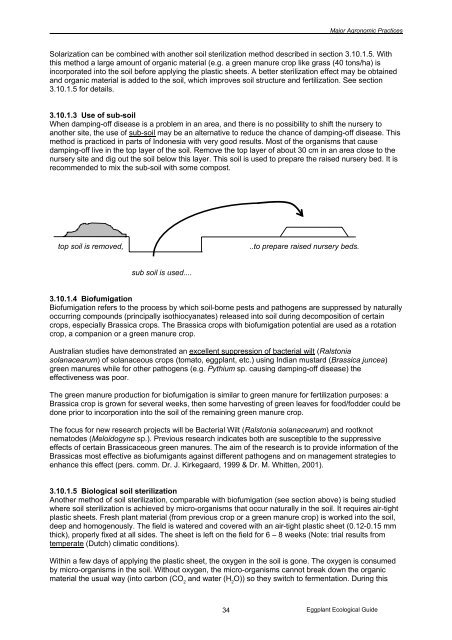Eggplant Integrated Pest Management AN ECOLOGICAL GUIDE
Eggplant Integrated Pest Management AN ECOLOGICAL GUIDE
Eggplant Integrated Pest Management AN ECOLOGICAL GUIDE
You also want an ePaper? Increase the reach of your titles
YUMPU automatically turns print PDFs into web optimized ePapers that Google loves.
___________________________________________________________________________________Major Agronomic PracticesSolarization can be combined with another soil sterilization method described in section 3.10.1.5. Withthis method a large amount of organic material (e.g. a green manure crop like grass (40 tons/ha) isincorporated into the soil before applying the plastic sheets. A better sterilization effect may be obtainedand organic material is added to the soil, which improves soil structure and fertilization. See section3.10.1.5 for details.3.10.1.3 Use of sub-soilWhen damping-off disease is a problem in an area, and there is no possibility to shift the nursery toanother site, the use of sub-soil may be an alternative to reduce the chance of damping-off disease. Thismethod is practiced in parts of Indonesia with very good results. Most of the organisms that causedamping-off live in the top layer of the soil. Remove the top layer of about 30 cm in an area close to thenursery site and dig out the soil below this layer. This soil is used to prepare the raised nursery bed. It isrecommended to mix the sub-soil with some compost.top soil is removed,..to prepare raised nursery beds.sub soil is used....3.10.1.4 BiofumigationBiofumigation refers to the process by which soil-borne pests and pathogens are suppressed by naturallyoccurring compounds (principally isothiocyanates) released into soil during decomposition of certaincrops, especially Brassica crops. The Brassica crops with biofumigation potential are used as a rotationcrop, a companion or a green manure crop.Australian studies have demonstrated an excellent suppression of bacterial wilt (Ralstoniasolanacearum) of solanaceous crops (tomato, eggplant, etc.) using Indian mustard (Brassica juncea)green manures while for other pathogens (e.g. Pythium sp. causing damping-off disease) theeffectiveness was poor.The green manure production for biofumigation is similar to green manure for fertilization purposes: aBrassica crop is grown for several weeks, then some harvesting of green leaves for food/fodder could bedone prior to incorporation into the soil of the remaining green manure crop.The focus for new research projects will be Bacterial Wilt (Ralstonia solanacearum) and rootknotnematodes (Meloidogyne sp.). Previous research indicates both are susceptible to the suppressiveeffects of certain Brassicaceous green manures. The aim of the research is to provide information of theBrassicas most effective as biofumigants against different pathogens and on management strategies toenhance this effect (pers. comm. Dr. J. Kirkegaard, 1999 & Dr. M. Whitten, 2001).3.10.1.5 Biological soil sterilizationAnother method of soil sterilization, comparable with biofumigation (see section above) is being studiedwhere soil sterilization is achieved by micro-organisms that occur naturally in the soil. It requires air-tightplastic sheets. Fresh plant material (from previous crop or a green manure crop) is worked into the soil,deep and homogenously. The field is watered and covered with an air-tight plastic sheet (0.12-0.15 mmthick), properly fixed at all sides. The sheet is left on the field for 6 – 8 weeks (Note: trial results fromtemperate (Dutch) climatic conditions).Within a few days of applying the plastic sheet, the oxygen in the soil is gone. The oxygen is consumedby micro-organisms in the soil. Without oxygen, the micro-organisms cannot break down the organicmaterial the usual way (into carbon (CO 2and water (H 2O)) so they switch to fermentation. During this34<strong>Eggplant</strong> Ecological Guide




![Section 4 [ PDF file, 252 KB] - The Field Alliance](https://img.yumpu.com/51387260/1/158x260/section-4-pdf-file-252-kb-the-field-alliance.jpg?quality=85)











